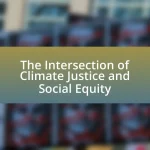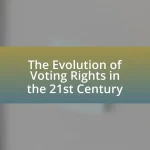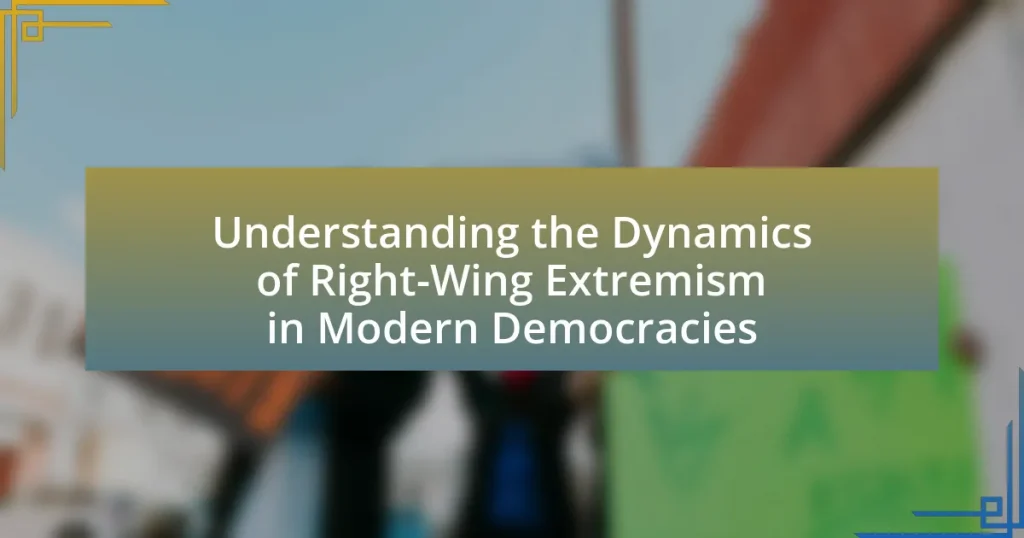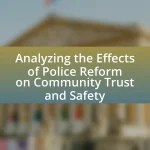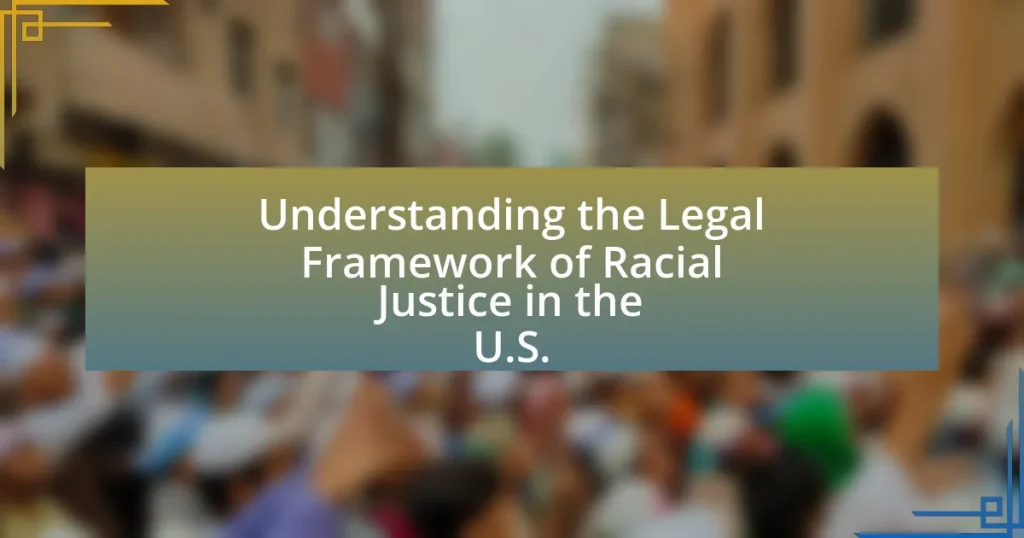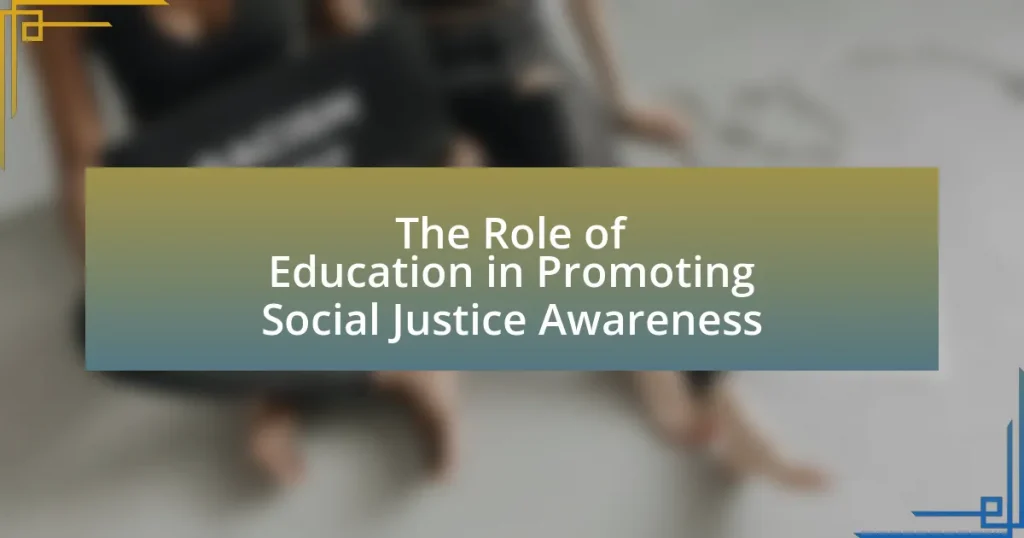Right-wing extremism in modern democracies encompasses political ideologies and movements that promote nationalist, xenophobic, and authoritarian principles, often rejecting liberal democratic values. This article examines the definition, characteristics, and historical context of right-wing extremism, highlighting its rise in various countries and the socio-economic factors contributing to its appeal. It also explores the role of social media in facilitating recruitment, the impacts on social cohesion and community relations, and the legal and security challenges posed by these extremist ideologies. Furthermore, the article discusses strategies for countering right-wing extremism, including education, community engagement, and policy reform, emphasizing the importance of addressing the underlying grievances that fuel these movements.

What is Right-Wing Extremism in Modern Democracies?
Right-wing extremism in modern democracies refers to political ideologies and movements that advocate for nationalist, xenophobic, and authoritarian principles, often characterized by a rejection of liberal democratic values. These movements typically promote the idea of ethnic or cultural superiority and may resort to violence or intimidation to achieve their goals. For instance, the rise of far-right parties in Europe, such as the National Rally in France and the Alternative for Germany, illustrates how mainstream political discourse has been influenced by extremist rhetoric, leading to increased polarization and social unrest. Additionally, the FBI reported that in the United States, right-wing extremists were responsible for the majority of domestic terrorism incidents in recent years, highlighting the tangible threat they pose to democratic institutions and social cohesion.
How is Right-Wing Extremism Defined?
Right-wing extremism is defined as a political ideology that promotes extreme nationalist, xenophobic, or authoritarian views, often accompanied by a belief in racial superiority and a rejection of democratic principles. This ideology manifests in various forms, including white supremacy, anti-immigrant sentiments, and opposition to social equality. Research indicates that right-wing extremist groups often engage in violent acts to achieve their goals, as evidenced by incidents such as the 2019 Christchurch mosque shootings, which were motivated by far-right beliefs.
What are the key characteristics of Right-Wing Extremism?
Right-wing extremism is characterized by a strong belief in nationalism, often accompanied by xenophobia and anti-immigrant sentiments. This ideology typically promotes the idea of racial superiority and advocates for the preservation of a perceived cultural identity, often at the expense of minority groups. Additionally, right-wing extremists may exhibit authoritarian tendencies, rejecting democratic norms and promoting violence as a means to achieve their goals. Historical evidence, such as the rise of far-right groups in Europe and the United States, illustrates these characteristics, with incidents like the Charlottesville rally in 2017 highlighting the violent expressions of this ideology.
How does Right-Wing Extremism differ from other forms of extremism?
Right-wing extremism primarily differs from other forms of extremism through its focus on nationalism, racial superiority, and anti-government sentiments. This ideology often emphasizes the preservation of a perceived cultural identity and the belief that certain races or ethnicities are superior to others, which is less prevalent in left-wing or religious extremism. For instance, right-wing extremist groups, such as white supremacists, advocate for policies that promote racial segregation and oppose immigration, contrasting with left-wing extremism that may focus on class struggle or social justice. According to the Federal Bureau of Investigation (FBI), right-wing extremists have been responsible for the majority of domestic terrorism incidents in the United States in recent years, highlighting their distinct impact on societal dynamics compared to other extremist ideologies.
What Historical Context Influences Right-Wing Extremism Today?
Right-wing extremism today is influenced by historical contexts such as post-World War I nationalism, the Great Depression, and the Cold War. The aftermath of World War I saw the rise of nationalist movements in Europe, which often scapegoated minorities and promoted xenophobia, laying the groundwork for extremist ideologies. The economic turmoil of the Great Depression further fueled discontent, leading to the emergence of far-right groups that capitalized on societal fears and economic instability. Additionally, during the Cold War, anti-communist sentiments and the promotion of traditional values contributed to the resurgence of right-wing extremism, as groups sought to protect perceived national identity against external threats. These historical events collectively shape the narratives and motivations of contemporary right-wing extremist movements, as they often invoke themes of nationalism, economic anxiety, and cultural preservation.
How have historical events shaped contemporary Right-Wing Extremist movements?
Historical events have significantly shaped contemporary Right-Wing Extremist movements by providing ideological foundations and mobilizing narratives. For instance, the aftermath of World War II and the Cold War fostered a climate of anti-communism and nationalism, which many modern right-wing groups exploit to rally support. The rise of globalization and demographic changes have also led to a resurgence of nativist sentiments, as seen in the backlash against immigration in various countries. Additionally, events such as the 9/11 attacks intensified Islamophobic sentiments, further galvanizing right-wing extremist ideologies that frame themselves as defenders of national identity. These historical contexts create a framework that contemporary movements utilize to justify their actions and recruit followers, demonstrating a direct lineage from past events to current extremist ideologies.
What role does nationalism play in the evolution of Right-Wing Extremism?
Nationalism serves as a foundational ideology that fuels the evolution of Right-Wing Extremism by promoting an exclusionary vision of national identity. This ideology often manifests in the belief that the nation should be preserved for a specific ethnic or cultural group, leading to xenophobia and anti-immigrant sentiments. Historical examples include the rise of nationalist movements in Europe during the early 20th century, which were characterized by the scapegoating of minorities and the glorification of a homogeneous national identity. The resurgence of nationalist rhetoric in contemporary politics, particularly in response to globalization and demographic changes, has further legitimized extremist views, as seen in the rise of parties like the National Front in France and the Alternative for Germany. These movements often exploit economic anxieties and cultural fears, reinforcing the connection between nationalism and Right-Wing Extremism.
What are the Main Ideologies Behind Right-Wing Extremism?
The main ideologies behind right-wing extremism include nationalism, anti-immigration sentiment, and authoritarianism. Nationalism emphasizes the superiority of one’s nation or ethnic group, often leading to exclusionary practices against perceived outsiders. Anti-immigration sentiment manifests in the belief that immigrants threaten cultural identity and economic stability, which is supported by various studies indicating a correlation between economic downturns and increased anti-immigrant rhetoric. Authoritarianism advocates for a strong, centralized government that prioritizes order and control, often at the expense of democratic freedoms. These ideologies are frequently reinforced by historical events, such as the rise of fascist movements in the early 20th century, which serve as cautionary examples of the dangers posed by right-wing extremism.
What beliefs and values are commonly associated with Right-Wing Extremist groups?
Right-Wing Extremist groups commonly associate with beliefs in nationalism, racial superiority, anti-immigration sentiments, and authoritarianism. These groups often promote the idea of preserving a perceived cultural identity, advocating for the supremacy of a particular race or ethnicity, and opposing multiculturalism. For instance, many right-wing extremists express hostility towards immigrants, viewing them as threats to national security and cultural integrity. Additionally, these groups frequently endorse authoritarian governance, believing that strong leadership is necessary to maintain social order and protect their values. Historical examples include the rise of fascist movements in Europe during the early 20th century, which were characterized by similar ideologies of nationalism and racial purity.
How do conspiracy theories contribute to Right-Wing Extremist ideologies?
Conspiracy theories significantly contribute to Right-Wing Extremist ideologies by providing a framework that justifies and amplifies their beliefs. These theories often portray a narrative of victimization, suggesting that a hidden elite is conspiring against the common people, which resonates with individuals feeling disenfranchised. For instance, the belief in a “deep state” undermines trust in democratic institutions and promotes the idea that only through radical action can the perceived threats be countered. Research from the Southern Poverty Law Center indicates that conspiracy theories are frequently used by extremist groups to recruit and radicalize individuals, as they create a sense of urgency and moral justification for extreme measures. This intertwining of conspiracy theories with Right-Wing Extremist ideologies fosters an environment where violence and intolerance are seen as acceptable responses to the alleged conspiracies.
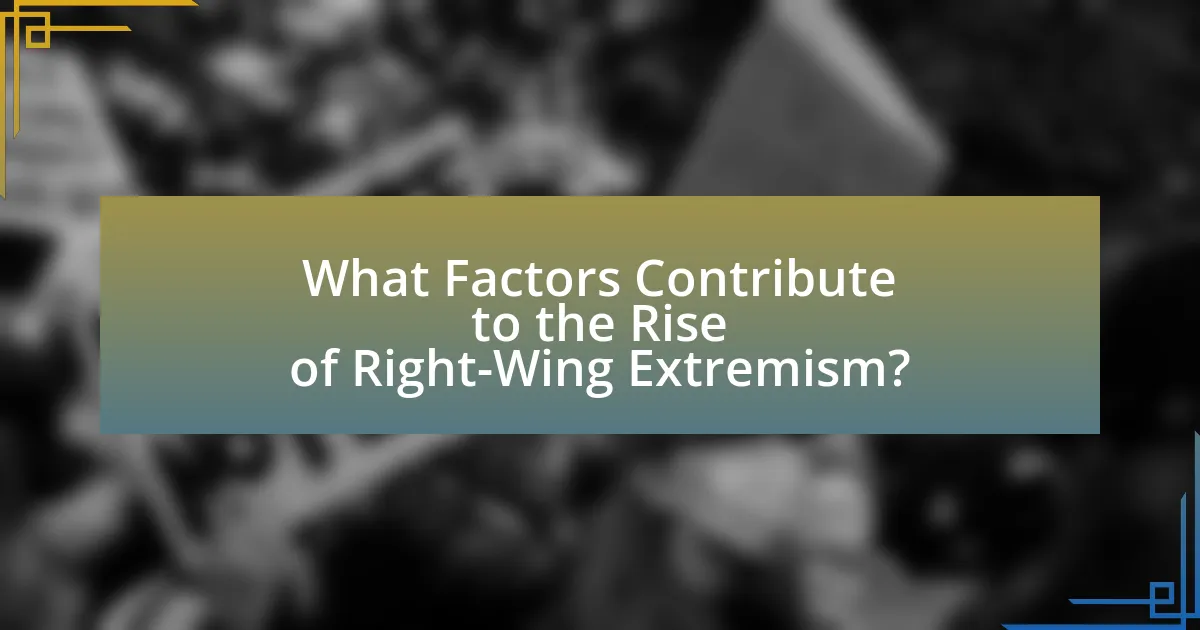
What Factors Contribute to the Rise of Right-Wing Extremism?
The rise of right-wing extremism is primarily driven by socio-economic factors, political polarization, and cultural anxieties. Economic instability, such as unemployment and income inequality, often leads individuals to seek scapegoats, which extremist groups exploit. Political polarization, characterized by a growing divide between ideological factions, fosters an environment where extremist views gain traction. Additionally, cultural anxieties surrounding immigration and national identity contribute to the appeal of right-wing extremism, as individuals feel threatened by perceived changes in societal norms. Research by the Southern Poverty Law Center indicates that hate groups have surged in response to these dynamics, highlighting the correlation between economic distress and the proliferation of extremist ideologies.
How do Economic Conditions Influence Right-Wing Extremism?
Economic conditions significantly influence right-wing extremism by creating environments of economic insecurity and social discontent. When unemployment rates rise or economic downturns occur, individuals may feel threatened and seek scapegoats, often targeting minority groups or immigrants. Research by the European Union Agency for Fundamental Rights indicates that economic crises can lead to increased support for far-right parties, as seen during the 2008 financial crisis when many European nations experienced a surge in right-wing populism. Additionally, studies show that areas with higher economic distress correlate with increased hate crimes and extremist group activity, highlighting the direct link between economic hardship and the rise of right-wing extremism.
What economic grievances are often exploited by Right-Wing Extremist groups?
Right-Wing Extremist groups often exploit economic grievances such as unemployment, wage stagnation, and economic inequality. These groups capitalize on the frustrations of individuals who feel left behind by globalization and technological advancements, often blaming immigrants and minority groups for their economic hardships. For instance, during economic downturns, such as the 2008 financial crisis, these extremist groups gained traction by promoting narratives that scapegoat marginalized communities, suggesting they are responsible for job losses and reduced wages. This exploitation of economic discontent is evidenced by the rise of far-right movements in various countries, where economic instability correlates with increased support for extremist ideologies.
How does economic inequality correlate with the rise of Right-Wing Extremism?
Economic inequality significantly correlates with the rise of Right-Wing Extremism, as disparities in wealth and opportunity can foster feelings of disenfranchisement and resentment among lower socioeconomic groups. Research indicates that regions experiencing high levels of economic inequality often see a corresponding increase in support for far-right political movements, which capitalize on fears related to job security, immigration, and cultural identity. For instance, a study by the Pew Research Center found that economic distress is a strong predictor of support for populist and extremist parties, particularly in countries like the United States and parts of Europe, where economic disparities have widened over the past few decades. This relationship suggests that as economic inequality grows, so too does the appeal of Right-Wing Extremism, which often promises to restore a perceived lost status or identity.
What Role Does Social Media Play in the Spread of Right-Wing Extremism?
Social media significantly facilitates the spread of right-wing extremism by providing platforms for like-minded individuals to connect, share ideologies, and organize activities. Research indicates that algorithms on platforms like Facebook and Twitter often promote extremist content due to user engagement metrics, leading to increased visibility of radical views. A study by the Institute for Strategic Dialogue found that right-wing extremist groups utilize social media to recruit members, disseminate propaganda, and coordinate events, amplifying their reach and influence. Furthermore, the anonymity and lack of regulation on these platforms allow for the rapid dissemination of misinformation and hate speech, contributing to the normalization of extremist ideologies in public discourse.
How do online platforms facilitate the recruitment of individuals into Right-Wing Extremist movements?
Online platforms facilitate the recruitment of individuals into Right-Wing Extremist movements by providing accessible spaces for like-minded individuals to connect, share ideologies, and organize activities. These platforms, such as social media and forums, enable the dissemination of extremist content, allowing users to encounter radical ideas that may resonate with their beliefs. Research indicates that algorithms on these platforms often promote content that aligns with users’ interests, which can lead to increased exposure to extremist narratives. For instance, a study by the Institute for Strategic Dialogue found that social media algorithms can create echo chambers, reinforcing extremist views and facilitating the normalization of radical ideologies. Additionally, online platforms allow for anonymity, which can lower the barriers to entry for individuals seeking to engage with extremist groups, making recruitment easier and more appealing.
What impact does social media have on the radicalization process?
Social media significantly accelerates the radicalization process by providing platforms for extremist ideologies to spread rapidly and connect like-minded individuals. Research indicates that social media facilitates the dissemination of propaganda, enabling groups to recruit and radicalize individuals more effectively than traditional methods. For instance, a study by the Institute for Strategic Dialogue found that extremist content on platforms like Facebook and Twitter can reach millions within hours, creating echo chambers that reinforce radical beliefs. Additionally, algorithms used by these platforms often promote divisive content, further entrenching users in extremist narratives.
How Do Political Climate and Policies Affect Right-Wing Extremism?
Political climate and policies significantly influence right-wing extremism by creating environments that either foster or mitigate extremist ideologies. For instance, during periods of economic instability or social unrest, right-wing extremist groups often gain traction as they exploit public fears and anxieties, promoting narratives that blame marginalized communities for societal issues. Research from the Southern Poverty Law Center indicates that hate groups in the United States surged during the 2008 financial crisis, correlating with a rise in anti-immigrant sentiment and xenophobia. Additionally, policies that emphasize nationalism or restrict immigration can embolden right-wing extremists, as seen in countries like Hungary and Poland, where government rhetoric has legitimized extremist views. Thus, the interplay between political climate and policies directly shapes the landscape of right-wing extremism, either by providing a platform for its growth or by implementing measures to counteract it.
What political rhetoric is commonly associated with the rise of Right-Wing Extremism?
Political rhetoric commonly associated with the rise of Right-Wing Extremism includes anti-immigrant sentiment, nationalism, and the promotion of traditional values. This rhetoric often frames immigrants as threats to national identity and security, which can be seen in the rise of populist leaders who utilize fear-based messaging to galvanize support. For instance, during the 2016 U.S. presidential election, Donald Trump’s campaign prominently featured anti-immigrant language, portraying immigrants as criminals and job stealers, which resonated with a significant portion of the electorate. Additionally, the rhetoric often emphasizes a return to “law and order,” appealing to those who feel marginalized by social changes. This pattern is supported by research from the Southern Poverty Law Center, which indicates a correlation between such rhetoric and increased hate crimes and extremist group activity.
How do government policies influence the visibility and activity of Right-Wing Extremist groups?
Government policies significantly influence the visibility and activity of Right-Wing Extremist groups by either enabling or constraining their operations. For instance, policies that promote free speech can lead to increased public demonstrations and online presence of these groups, as seen in countries like the United States, where First Amendment protections allow for the expression of extremist views. Conversely, stringent anti-terrorism laws and hate speech regulations can limit their activities, as evidenced by the crackdown on extremist groups in Germany, which has led to a decrease in their public visibility and recruitment efforts. Additionally, government funding for counter-extremism initiatives can further diminish the influence of these groups by promoting alternative narratives and community resilience against radicalization.
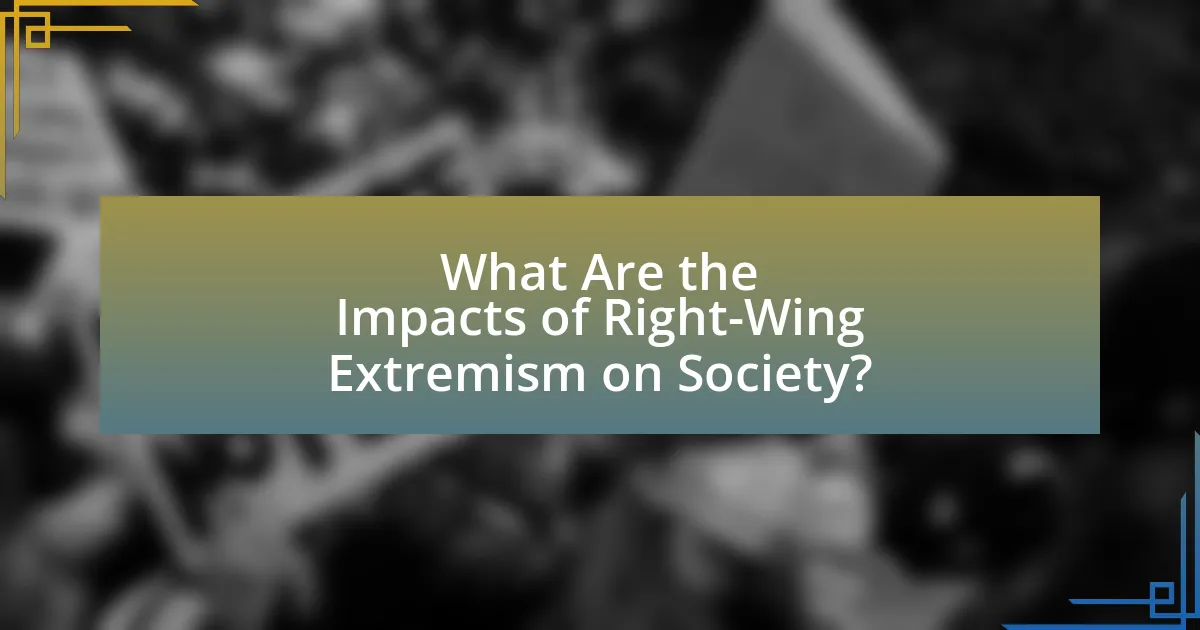
What Are the Impacts of Right-Wing Extremism on Society?
Right-wing extremism negatively impacts society by fostering division, violence, and discrimination. This ideology often leads to increased hate crimes, as evidenced by the FBI’s Hate Crime Statistics report, which indicates that in 2020, 55.5% of hate crimes were motivated by race/ethnicity/ancestry bias, with a significant portion linked to right-wing extremist groups. Additionally, right-wing extremism undermines social cohesion, as it promotes xenophobia and intolerance, contributing to a climate of fear and hostility among marginalized communities. The Southern Poverty Law Center reported a rise in hate groups, many of which espouse right-wing extremist views, indicating a growing normalization of such ideologies in public discourse.
How Does Right-Wing Extremism Affect Social Cohesion?
Right-wing extremism negatively affects social cohesion by fostering division and hostility among different social groups. This ideology often promotes xenophobia, racism, and nationalism, which can lead to increased tensions and conflict within communities. For instance, studies have shown that countries experiencing a rise in right-wing extremist movements, such as the United States and several European nations, report higher levels of social polarization and hate crimes. According to a report by the Southern Poverty Law Center, hate groups in the U.S. have increased significantly, correlating with a decline in community trust and social solidarity. This evidence illustrates that right-wing extremism undermines the fabric of social cohesion by creating an environment of fear and mistrust among diverse populations.
What are the consequences of Right-Wing Extremism on community relations?
Right-wing extremism significantly deteriorates community relations by fostering division and hostility among diverse groups. This ideology often promotes xenophobia, racism, and intolerance, leading to increased social polarization. For instance, a report by the Southern Poverty Law Center indicates that hate crimes and incidents of violence against minority communities rise in areas with active right-wing extremist groups. Furthermore, community cohesion is undermined as trust diminishes between different ethnic and social groups, resulting in a fragmented society. The presence of right-wing extremism can also lead to increased surveillance and policing of marginalized communities, further exacerbating tensions and fear.
How does Right-Wing Extremism contribute to societal polarization?
Right-wing extremism contributes to societal polarization by fostering an “us versus them” mentality that deepens divisions between different social groups. This ideology often promotes xenophobia, nationalism, and anti-establishment sentiments, which can lead to increased hostility towards marginalized communities and political opponents. For instance, research from the Southern Poverty Law Center indicates that the number of hate groups in the United States has risen significantly, correlating with a rise in right-wing extremist rhetoric and actions. This escalation in extremist views not only alienates individuals from opposing perspectives but also creates an environment where dialogue and compromise become increasingly difficult, further entrenching societal divides.
What Are the Legal and Security Challenges Posed by Right-Wing Extremism?
Right-wing extremism poses significant legal and security challenges, primarily through the promotion of hate crimes, domestic terrorism, and the undermining of democratic institutions. Legal challenges arise from the difficulty in defining and prosecuting hate speech and actions that fall under the umbrella of free speech protections, complicating law enforcement’s ability to act against extremist groups. Security challenges include the increasing frequency of violent incidents linked to right-wing extremists, as evidenced by the FBI’s report indicating that domestic terrorism, particularly from right-wing groups, has become a leading threat in the United States. Additionally, the rise of online radicalization platforms complicates monitoring and prevention efforts, as these platforms facilitate the spread of extremist ideologies and recruitment.
How do law enforcement agencies respond to Right-Wing Extremist threats?
Law enforcement agencies respond to Right-Wing Extremist threats through intelligence gathering, monitoring of extremist groups, and proactive intervention strategies. These agencies utilize tools such as threat assessments and community engagement to identify potential risks and prevent violent acts. For instance, the FBI’s Domestic Terrorism Program focuses on tracking and analyzing the activities of right-wing extremist groups, which have been linked to a significant number of domestic terrorist incidents in the United States, as reported by the Department of Homeland Security. Additionally, collaboration with local law enforcement and community organizations enhances the effectiveness of these responses, allowing for a more comprehensive approach to mitigating threats posed by right-wing extremism.
What legal frameworks exist to combat Right-Wing Extremism?
Legal frameworks to combat Right-Wing Extremism include anti-terrorism laws, hate crime legislation, and specific statutes targeting extremist organizations. For instance, many countries have enacted laws that criminalize hate speech and incitement to violence, which directly address the rhetoric often used by right-wing extremists. In the United States, the Patriot Act enhances law enforcement’s ability to monitor and prevent domestic terrorism, including actions motivated by right-wing ideologies. Similarly, in Germany, the Federal Criminal Police Office employs laws that prohibit the promotion of extremist ideologies and the dissemination of hate propaganda. These frameworks are designed to provide law enforcement with the tools necessary to investigate, prosecute, and prevent acts of violence associated with right-wing extremism.
What Strategies Can Be Implemented to Counter Right-Wing Extremism?
To counter right-wing extremism, strategies such as community engagement, education, and policy reform can be implemented. Community engagement involves fostering dialogue among diverse groups to build understanding and resilience against extremist narratives. Education initiatives can focus on critical thinking and media literacy to help individuals recognize and reject extremist ideologies. Policy reform may include stricter regulations on hate speech and funding for programs that promote social cohesion. Research indicates that countries with proactive community programs and educational initiatives have seen a reduction in extremist activities, demonstrating the effectiveness of these strategies.
How can education and awareness programs mitigate the influence of Right-Wing Extremism?
Education and awareness programs can mitigate the influence of Right-Wing Extremism by promoting critical thinking, fostering inclusivity, and providing accurate information about diverse cultures and histories. These programs equip individuals with the skills to analyze extremist narratives and recognize misinformation, thereby reducing susceptibility to radical ideologies. For instance, studies have shown that educational interventions that emphasize empathy and understanding of different perspectives can decrease prejudiced attitudes and behaviors. A report by the Institute for Strategic Dialogue highlights that community-based educational initiatives have successfully engaged youth, leading to a measurable decline in extremist recruitment in various regions.
What role do community initiatives play in preventing Right-Wing Extremist recruitment?
Community initiatives play a crucial role in preventing Right-Wing Extremist recruitment by fostering social cohesion and providing alternative narratives to extremist ideologies. These initiatives often engage local populations through educational programs, community dialogues, and outreach efforts that promote inclusivity and diversity. Research indicates that communities with strong social ties and active participation in local governance are less susceptible to extremist influences, as they create environments where individuals feel valued and connected. For example, a study by the Institute for Strategic Dialogue found that community-led interventions significantly reduced the appeal of extremist groups by addressing underlying grievances and offering support networks.
What Practical Steps Can Individuals Take to Address Right-Wing Extremism?
Individuals can take several practical steps to address right-wing extremism, including educating themselves and others about the dangers of extremist ideologies. Engaging in community dialogues and promoting inclusivity can help counteract divisive narratives. Additionally, reporting hate speech and extremist activities to authorities can aid in preventing the spread of such ideologies. Research indicates that community engagement and education significantly reduce the appeal of extremist groups, as highlighted in the report “The Role of Community in Preventing Violent Extremism” by the Institute for Strategic Dialogue.



